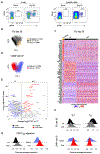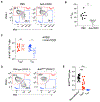T resident helper cells promote humoral responses in the lung
- PMID: 33419790
- PMCID: PMC8063390
- DOI: 10.1126/sciimmunol.abb6808
T resident helper cells promote humoral responses in the lung
Abstract
Influenza is a deadly and costly infectious disease, even during flu seasons when an effective vaccine has been developed. To improve vaccines against respiratory viruses, a better understanding of the immune response at the site of infection is crucial. After influenza infection, clonally expanded T cells take up permanent residence in the lung, poised to rapidly respond to subsequent infection. Here, we characterized the dynamics and transcriptional regulation of lung-resident CD4+ T cells during influenza infection and identified a long-lived, Bcl6-dependent population that we have termed T resident helper (TRH) cells. TRH cells arise in the lung independently of lymph node T follicular helper cells but are dependent on B cells, with which they tightly colocalize in inducible bronchus-associated lymphoid tissue (iBALT). Deletion of Bcl6 in CD4+ T cells before heterotypic challenge infection resulted in redistribution of CD4+ T cells outside of iBALT areas and impaired local antibody production. These results highlight iBALT as a homeostatic niche for TRH cells and advocate for vaccination strategies that induce TRH cells in the lung.
Copyright © 2021 The Authors, some rights reserved; exclusive licensee American Association for the Advancement of Science. No claim to original U.S. Government Works.
Conflict of interest statement
Figures








Comment in
-
TRH cells, helpers making an impact in their local community.Sci Immunol. 2021 Jan 8;6(55):eabf2886. doi: 10.1126/sciimmunol.abf2886. Sci Immunol. 2021. PMID: 33419792
Similar articles
-
Tissue-resident CD4+ T helper cells assist the development of protective respiratory B and CD8+ T cell memory responses.Sci Immunol. 2021 Jan 8;6(55):eabb6852. doi: 10.1126/sciimmunol.abb6852. Sci Immunol. 2021. PMID: 33419791 Free PMC article.
-
CCR2 Regulates Vaccine-Induced Mucosal T-Cell Memory to Influenza A Virus.J Virol. 2021 Jul 12;95(15):e0053021. doi: 10.1128/JVI.00530-21. Epub 2021 Jul 12. J Virol. 2021. PMID: 33952647 Free PMC article.
-
Inducible Bronchus-Associated Lymphoid Tissues (iBALT) Serve as Sites of B Cell Selection and Maturation Following Influenza Infection in Mice.Front Immunol. 2019 Mar 29;10:611. doi: 10.3389/fimmu.2019.00611. eCollection 2019. Front Immunol. 2019. PMID: 30984186 Free PMC article.
-
T Cell Immunity against Influenza: The Long Way from Animal Models Towards a Real-Life Universal Flu Vaccine.Viruses. 2021 Jan 28;13(2):199. doi: 10.3390/v13020199. Viruses. 2021. PMID: 33525620 Free PMC article. Review.
-
Memory CD4 T cell-mediated immunity against influenza A virus: more than a little helpful.Arch Immunol Ther Exp (Warsz). 2013 Oct;61(5):341-53. doi: 10.1007/s00005-013-0236-z. Epub 2013 May 25. Arch Immunol Ther Exp (Warsz). 2013. PMID: 23708562 Free PMC article. Review.
Cited by
-
Lung tissue-resident memory T cells: the gatekeeper to respiratory viral (re)-infection.Curr Opin Immunol. 2023 Feb;80:102278. doi: 10.1016/j.coi.2022.102278. Epub 2022 Dec 22. Curr Opin Immunol. 2023. PMID: 36565508 Free PMC article. Review.
-
Strong influenza-induced TFH generation requires CD4 effectors to recognize antigen locally and receive signals from continuing infection.Proc Natl Acad Sci U S A. 2022 Feb 22;119(8):e2111064119. doi: 10.1073/pnas.2111064119. Proc Natl Acad Sci U S A. 2022. PMID: 35177472 Free PMC article.
-
Intranasal administration of a recombinant RBD vaccine induces long-term immunity against Omicron-included SARS-CoV-2 variants.Signal Transduct Target Ther. 2022 May 17;7(1):159. doi: 10.1038/s41392-022-01002-1. Signal Transduct Target Ther. 2022. PMID: 35581200 Free PMC article.
-
Local memory CD4 T cell niches in respiratory viral infection.J Exp Med. 2021 Aug 2;218(8):e20201733. doi: 10.1084/jem.20201733. Epub 2021 Jun 23. J Exp Med. 2021. PMID: 34160551 Free PMC article.
-
Exacerbated lung inflammation in offspring with high maternal antibody levels following secondary RSV exposure.Front Immunol. 2024 Apr 30;15:1377374. doi: 10.3389/fimmu.2024.1377374. eCollection 2024. Front Immunol. 2024. PMID: 38745662 Free PMC article.
References
-
- Palache A, Abelin A, Hollingsworth R, Cracknell W, Jacobs C, Tsai T, Barbosa P; IFPMA Influenza Vaccine Supply (IFPMA IVS) task force, Survey of distribution of seasonal influenza vaccine doses in 201 countries (2004-2015): The 2003 World Health Assembly resolution on seasonal influenza vaccination coverage and the 2009 influenza pandemic have had very little impact on improving influenza control and pandemic preparedness. Vaccine 35, 4681–4686 (2017). - PubMed
-
- Sambhara S, Kurichh A, Miranda R, Tumpey T, Rowe T, Renshaw M, Arpino R, Tamane A, Kandil A, James O, Underdown B, Klein M, Katz J, Burt D, Heterosubtypic immunity against human influenza A viruses, including recently emerged avian H5 and H9 viruses, induced by FLU-ISCOM vaccine in mice requires both cytotoxic T-lymphocyte and macrophage function. Cell. Immunol. 211,143–153 (2001). - PubMed
Publication types
MeSH terms
Substances
Grants and funding
LinkOut - more resources
Full Text Sources
Other Literature Sources
Medical
Research Materials

